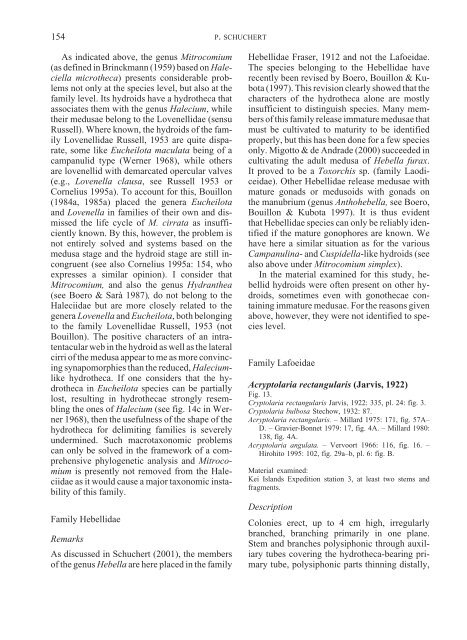Hydroids (Cnidaria, Hydrozoa) of the Danish expedition to
Hydroids (Cnidaria, Hydrozoa) of the Danish expedition to
Hydroids (Cnidaria, Hydrozoa) of the Danish expedition to
Create successful ePaper yourself
Turn your PDF publications into a flip-book with our unique Google optimized e-Paper software.
154<br />
As indicated above, <strong>the</strong> genus Mitrocomium<br />
(as defined in Brinckmann (1959) based on Haleciella<br />
micro<strong>the</strong>ca) presents considerable problems<br />
not only at <strong>the</strong> species level, but also at <strong>the</strong><br />
family level. Its hydroids have a hydro<strong>the</strong>ca that<br />
associates <strong>the</strong>m with <strong>the</strong> genus Halecium, while<br />
<strong>the</strong>ir medusae belong <strong>to</strong> <strong>the</strong> Lovenellidae (sensu<br />
Russell). Where known, <strong>the</strong> hydroids <strong>of</strong> <strong>the</strong> family<br />
Lovenellidae Russell, 1953 are quite disparate,<br />
some like Eucheilota maculata being <strong>of</strong> a<br />
campanulid type (Werner 1968), while o<strong>the</strong>rs<br />
are lovenellid with demarcated opercular valves<br />
(e.g., Lovenella clausa, see Russell 1953 or<br />
Cornelius 1995a). To account for this, Bouillon<br />
(1984a, 1985a) placed <strong>the</strong> genera Eucheilota<br />
and Lovenella in families <strong>of</strong> <strong>the</strong>ir own and dismissed<br />
<strong>the</strong> life cycle <strong>of</strong> M. cirrata as insufficiently<br />
known. By this, however, <strong>the</strong> problem is<br />
not entirely solved and systems based on <strong>the</strong><br />
medusa stage and <strong>the</strong> hydroid stage are still incongruent<br />
(see also Cornelius 1995a: 154, who<br />
expresses a similar opinion). I consider that<br />
Mitrocomium, and also <strong>the</strong> genus Hydran<strong>the</strong>a<br />
(see Boero & Sarà 1987), do not belong <strong>to</strong> <strong>the</strong><br />
Haleciidae but are more closely related <strong>to</strong> <strong>the</strong><br />
genera Lovenella and Eucheilota, both belonging<br />
<strong>to</strong> <strong>the</strong> family Lovenellidae Russell, 1953 (not<br />
Bouillon). The positive characters <strong>of</strong> an intratentacular<br />
web in <strong>the</strong> hydroid as well as <strong>the</strong> lateral<br />
cirri <strong>of</strong> <strong>the</strong> medusa appear <strong>to</strong> me as more convincing<br />
synapomorphies than <strong>the</strong> reduced, Haleciumlike<br />
hydro<strong>the</strong>ca. If one considers that <strong>the</strong> hydro<strong>the</strong>ca<br />
in Eucheilota species can be partially<br />
lost, resulting in hydro<strong>the</strong>cae strongly resembling<br />
<strong>the</strong> ones <strong>of</strong> Halecium (see fig. 14c in Werner<br />
1968), <strong>the</strong>n <strong>the</strong> usefulness <strong>of</strong> <strong>the</strong> shape <strong>of</strong> <strong>the</strong><br />
hydro<strong>the</strong>ca for delimiting families is severely<br />
undermined. Such macrotaxonomic problems<br />
can only be solved in <strong>the</strong> framework <strong>of</strong> a comprehensive<br />
phylogenetic analysis and Mitrocomium<br />
is presently not removed from <strong>the</strong> Haleciidae<br />
as it would cause a major taxonomic instability<br />
<strong>of</strong> this family.<br />
Family Hebellidae<br />
Remarks<br />
As discussed in Schuchert (2001), <strong>the</strong> members<br />
<strong>of</strong> <strong>the</strong> genus Hebella are here placed in <strong>the</strong> family<br />
P. SCHUCHERT<br />
Hebellidae Fraser, 1912 and not <strong>the</strong> Lafoeidae.<br />
The species belonging <strong>to</strong> <strong>the</strong> Hebellidae have<br />
recently been revised by Boero, Bouillon & Kubota<br />
(1997). This revision clearly showed that <strong>the</strong><br />
characters <strong>of</strong> <strong>the</strong> hydro<strong>the</strong>ca alone are mostly<br />
insufficient <strong>to</strong> distinguish species. Many members<br />
<strong>of</strong> this family release immature medusae that<br />
must be cultivated <strong>to</strong> maturity <strong>to</strong> be identified<br />
properly, but this has been done for a few species<br />
only. Migot<strong>to</strong> & de Andrade (2000) succeeded in<br />
cultivating <strong>the</strong> adult medusa <strong>of</strong> Hebella furax.<br />
It proved <strong>to</strong> be a Toxorchis sp. (family Laodiceidae).<br />
O<strong>the</strong>r Hebellidae release medusae with<br />
mature gonads or medusoids with gonads on<br />
<strong>the</strong> manubrium (genus Anthohebella, see Boero,<br />
Bouillon & Kubota 1997). It is thus evident<br />
that Hebellidae species can only be reliably identified<br />
if <strong>the</strong> mature gonophores are known. We<br />
have here a similar situation as for <strong>the</strong> various<br />
Campanulina- and Cuspidella-like hydroids (see<br />
also above under Mitrocomium simplex).<br />
In <strong>the</strong> material examined for this study, hebellid<br />
hydroids were <strong>of</strong>ten present on o<strong>the</strong>r hydroids,<br />
sometimes even with gono<strong>the</strong>cae containing<br />
immature medusae. For <strong>the</strong> reasons given<br />
above, however, <strong>the</strong>y were not identified <strong>to</strong> species<br />
level.<br />
Family Lafoeidae<br />
Acryp<strong>to</strong>laria rectangularis (Jarvis, 1922)<br />
Fig. 13.<br />
Cryp<strong>to</strong>laria rectangularis Jarvis, 1922: 335, pl. 24: fig. 3.<br />
Cryp<strong>to</strong>laria bulbosa Stechow, 1932: 87.<br />
Acryp<strong>to</strong>laria rectangularis. – Millard 1975: 171, fig. 57A–<br />
D. – Gravier-Bonnet 1979: 17, fig. 4A. – Millard 1980:<br />
138, fig. 4A.<br />
Acryp<strong>to</strong>laria angulata. – Vervoort 1966: 116, fig. 16. –<br />
Hirohi<strong>to</strong> 1995: 102, fig. 29a–b, pl. 6: fig. B.<br />
Material examined:<br />
Kei Islands Expedition station 3, at least two stems and<br />
fragments.<br />
Description<br />
Colonies erect, up <strong>to</strong> 4 cm high, irregularly<br />
branched, branching primarily in one plane.<br />
Stem and branches polysiphonic through auxiliary<br />
tubes covering <strong>the</strong> hydro<strong>the</strong>ca-bearing primary<br />
tube, polysiphonic parts thinning distally,

















